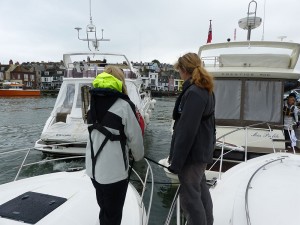Berthing in windy conditions
Newsletter Articles Many a great day out on the water has ended not quite as planned as the wind has got up whilst you were at sea, with a net result that even before you have arrived back at your marina, your stress level is already through the roof. Windy conditions are what most skippers fear, in reality like most afloat the key is planning what you intend to happen and briefing the crew accordingly before you actually get into a confined area. At sea on a windier day the wind direction is reasonably constant, closer to land the wind can often become gustier with sudden shifts in direction, especially around buildings.
Many a great day out on the water has ended not quite as planned as the wind has got up whilst you were at sea, with a net result that even before you have arrived back at your marina, your stress level is already through the roof. Windy conditions are what most skippers fear, in reality like most afloat the key is planning what you intend to happen and briefing the crew accordingly before you actually get into a confined area. At sea on a windier day the wind direction is reasonably constant, closer to land the wind can often become gustier with sudden shifts in direction, especially around buildings.
So key before arrival is to establish what the overriding wind is and where it is pushing you – this gives you the downwind ‘Danger Zone’
- This downwind area is where you will be swept if you get it incorrect, or a gust catches you out. Monitor it all the time.
- Key is keeping the boat balanced on the wind so it’s in a neutral safe position.
- Learn to control the bow without thrusters, yes they are really useful but if you have good natural control with the engines they become an aid rather than a primary control.
- If you know your berths location, is the wind helping? i.e. are you being swept onto or off the berth?
- Wind on the stern can be used to steady the boat.
- When actually mooring the boat is the wind going to be on the bow or the stern? If the is wind on the bow and gusty, perhaps consider an alternative berth especially if you do not have a bow thruster.
- With a motorboat be wary of relying on the thruster to save the boat if its not going to plan, they should be an aid and not a primary method of turning or berthing.
- Make sure the crew are well briefed with which line is the priority line. This will usually be one at the upwind area of the boat, – wind on the bow – bow line first. Wind on the stern – stern line first.
- Watch very carefully where the stern is in relation to any danger areas simply because a motorboats pivot point will bring the stern closer if you attempt to turn ‘away’ from the danger.
- Identify the correct starting position, ideally downwind of where you want to go, this is absolutely crucial on a windy day, most berthing attempts that go badly are started from the wrong start position.
Now the best thing that you can do is make the wind your friend. Motorboats especially planing ones, by definition have a relatively small underwater profile with lots of topsides to accommodate the living space. This generally means that they can be affected a lot by the wind. So try to use the wind so that the boat is balanced against it, this is much the same way as ferry gliding on a tidal stream, a good helm can balance the boat on the wind. Just remember to watch for gusts, as you need to be able to read the wind in ADVANCE of the gust so it does not catch you out.
The people that make it look easy have really only an over developed skill at reading the conditions and your practice at this is what will make you a better boater. So reading the gusts, and moving the boat early so it’s closer to the safe, windward side before a gust hits you is a key skill which you can practice every time you go out. Even on gentle days there will be enough wind to learn to read it, it may not need a movement now but the awareness is the skill that you need to build.
Getting berthed just needs a simple plan, with if possible the wind acting as a brake to the boats momentum. This can sometimes mean actually going past your intended berth, turning round and approaching from the other direction so the wind and any gusts are not accelerating you into danger.
